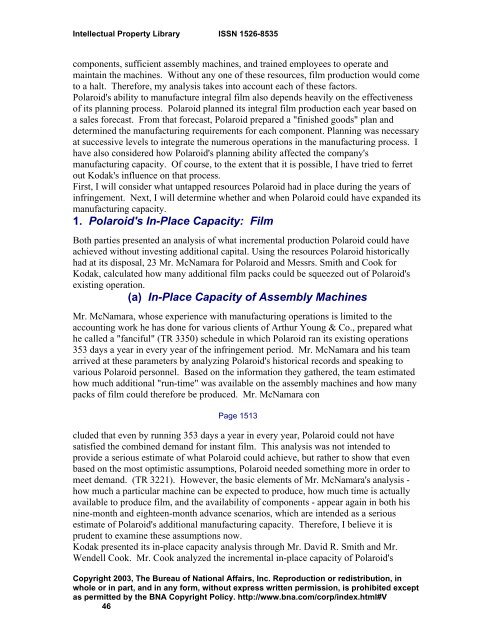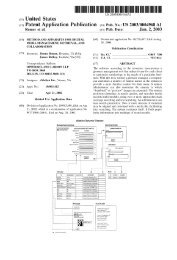Polaroid Corp. v. Eastman Kodak Co. - Oppedahl Patent Law Firm LLC
Polaroid Corp. v. Eastman Kodak Co. - Oppedahl Patent Law Firm LLC
Polaroid Corp. v. Eastman Kodak Co. - Oppedahl Patent Law Firm LLC
You also want an ePaper? Increase the reach of your titles
YUMPU automatically turns print PDFs into web optimized ePapers that Google loves.
Intellectual Property Library ISSN 1526-8535<br />
components, sufficient assembly machines, and trained employees to operate and<br />
maintain the machines. Without any one of these resources, film production would come<br />
to a halt. Therefore, my analysis takes into account each of these factors.<br />
<strong>Polaroid</strong>'s ability to manufacture integral film also depends heavily on the effectiveness<br />
of its planning process. <strong>Polaroid</strong> planned its integral film production each year based on<br />
a sales forecast. From that forecast, <strong>Polaroid</strong> prepared a "finished goods" plan and<br />
determined the manufacturing requirements for each component. Planning was necessary<br />
at successive levels to integrate the numerous operations in the manufacturing process. I<br />
have also considered how <strong>Polaroid</strong>'s planning ability affected the company's<br />
manufacturing capacity. Of course, to the extent that it is possible, I have tried to ferret<br />
out <strong>Kodak</strong>'s influence on that process.<br />
First, I will consider what untapped resources <strong>Polaroid</strong> had in place during the years of<br />
infringement. Next, I will determine whether and when <strong>Polaroid</strong> could have expanded its<br />
manufacturing capacity.<br />
1. <strong>Polaroid</strong>'s In-Place Capacity: Film<br />
Both parties presented an analysis of what incremental production <strong>Polaroid</strong> could have<br />
achieved without investing additional capital. Using the resources <strong>Polaroid</strong> historically<br />
had at its disposal, 23 Mr. McNamara for <strong>Polaroid</strong> and Messrs. Smith and <strong>Co</strong>ok for<br />
<strong>Kodak</strong>, calculated how many additional film packs could be squeezed out of <strong>Polaroid</strong>'s<br />
existing operation.<br />
(a) In-Place Capacity of Assembly Machines<br />
Mr. McNamara, whose experience with manufacturing operations is limited to the<br />
accounting work he has done for various clients of Arthur Young & <strong>Co</strong>., prepared what<br />
he called a "fanciful" (TR 3350) schedule in which <strong>Polaroid</strong> ran its existing operations<br />
353 days a year in every year of the infringement period. Mr. McNamara and his team<br />
arrived at these parameters by analyzing <strong>Polaroid</strong>'s historical records and speaking to<br />
various <strong>Polaroid</strong> personnel. Based on the information they gathered, the team estimated<br />
how much additional "run-time" was available on the assembly machines and how many<br />
packs of film could therefore be produced. Mr. McNamara con<br />
Page 1513<br />
cluded that even by running 353 days a year in every year, <strong>Polaroid</strong> could not have<br />
satisfied the combined demand for instant film. This analysis was not intended to<br />
provide a serious estimate of what <strong>Polaroid</strong> could achieve, but rather to show that even<br />
based on the most optimistic assumptions, <strong>Polaroid</strong> needed something more in order to<br />
meet demand. (TR 3221). However, the basic elements of Mr. McNamara's analysis -<br />
how much a particular machine can be expected to produce, how much time is actually<br />
available to produce film, and the availability of components - appear again in both his<br />
nine-month and eighteen-month advance scenarios, which are intended as a serious<br />
estimate of <strong>Polaroid</strong>'s additional manufacturing capacity. Therefore, I believe it is<br />
prudent to examine these assumptions now.<br />
<strong>Kodak</strong> presented its in-place capacity analysis through Mr. David R. Smith and Mr.<br />
Wendell <strong>Co</strong>ok. Mr. <strong>Co</strong>ok analyzed the incremental in-place capacity of <strong>Polaroid</strong>'s<br />
<strong>Co</strong>pyright 2003, The Bureau of National Affairs, Inc. Reproduction or redistribution, in<br />
whole or in part, and in any form, without express written permission, is prohibited except<br />
as permitted by the BNA <strong>Co</strong>pyright Policy. http://www.bna.com/corp/index.html#V<br />
46





